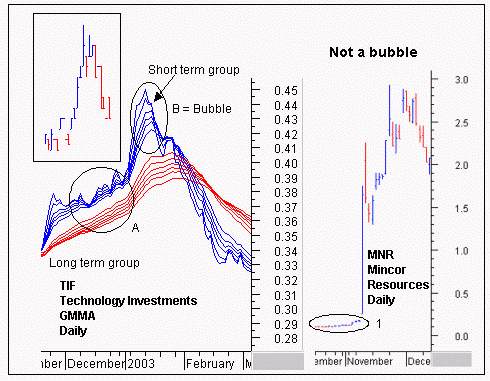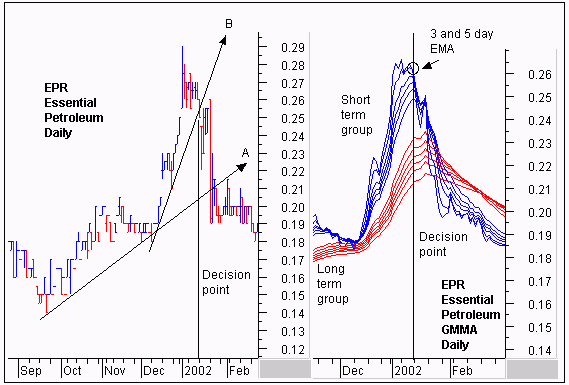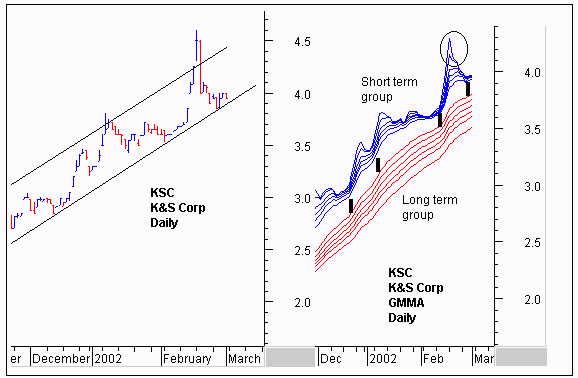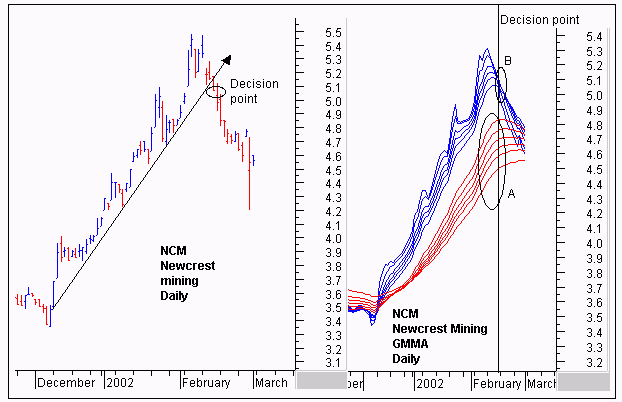THE GMMA - BUBBLE TRADING
This is the last in the series of notes on GMMA applications. Bubble trading is a speculative activity. It calls for good trading skills and excellent trading discipline. The objective is to ride the momentum driven bubble for as long as possible. Exits are fine tuned using a variety of volatility based indicators and techniques. The end of day chart is used to set the general scene for the exit, but the actual exit is usually managed using intraday trading tools. Many traders avoid speculative bubble trading because it is so demanding. However, there are times when we enter a trade which shows a steady trend, only to find that a bubble develops. This poses several dangers and some temptations.
First the dangers. Bubbles inevitably burst. When they collapse prices often fall from a great height. In some cases this fall is fast enough and hard enough to seriously weaken the underlying trend. Bubble collapses can wipe out not only bubble profits, but also profits accumulated over many weeks or months. Recognizing these bubbles is a useful skill to develop because we can limit the damage from a bubble collapse.
If we have not set out to trade a bubble, then we may be tempted to take profits from the temporary bubble as it develops. This is a sound strategy, and can be used to protect profits or take opportunity profits, while still intending to remain with the underlying trend.
Many investors simply ignore the bubble, letting it collapse back to the trend. This may mean ignoring exit signals generated by other indicators. The bubble trade in this situation can attack our trading discipline. Traders need to be clear on when it is appropriate to ignore volatility based stop loss indicators in this situation.
The GMMA is used to understand three types of bubbles:
The speculative bubble. This is a distinct trading strategy. Trades are selected for this characteristic.
Bubbles in a strong trend. Managing these bubbles means balancing temptation with danger, and understanding when it is appropriate to ignore other exit signals.
End of trend bubbles. These are the most difficult to assess, because when they burst they take the trend with them.
Bubble identification
The TIF chart shows the essential characteristic of a bubble. This is not a subtle chart development. Most times it is very clear on the bar chart, as shown in the extract. What makes this a bubble is the change in the nature of the trend. This is not an accelerating, or fast moving trend. A bubble occurs in an established trend. It represents the final burst of speculative activity based on a trend that has already developed. Just like a bubbling pot of soup, this price bubble lifts above the surface, bursts, and then collapses back to the surface.
The bubble should not be confused with a chart like MCR. Here is a dramatic and sudden change in price activity. This is a momentum driven trade from beginning to end. This is not a bubble on an existing trend. The `bubble' is the trend. When it collapses, or develops into a more stable trend, the starting point will be well above the original trend or surface in area 1.
Price activity, and GMMA relationships, are different in the bubble area. Area A shows a steady and consistent degree of separation between the long term and short term groups of moving averages. Area B shows a substantial widening of this gap. Prices shoot well above what investors are prepared to pay.

The trading activity of expansion and compression is not dramatic in area A. In area B, the expansion of the short term group is significantly greater than in area A. The steepness of the slope increases, and the degree of separation within the short term group also increases dramatically. The wider the spacing in this group the greater the level of overexcited competition amongst traders. They are aggressively outbidding each other to get hold of stock. This simply cannot last for long because it calls for new money to buy at ever increasing prices. When traders try to lock in profits they do so aggressively. This means meeting the bid rather than waiting for prices to lift to their ask. The result is a sudden tumble in the short term averages, which leads to a cascade of lower offers. Potential buyers no longer need to bid as high. Prices collapse as the bubble is pricked.
The final identification feature is the change in frequency of the traders compression and expansion activity. Area A covers four weeks and shows three peaks in the short term group of averages. Area B covers a similar time period, but includes only a single peak. This is a change in the nature of the trading activity.
This is a classic bubble and in this case, as a classic speculative bubble.
Speculative bubbles.

The GMMA confirms what we see on the bar chart. Trend line A defines the potential longer term up trend with EPR. The momentum driven bubble is defined by trend line B. This line hugs the fast and steep upwards move. The trader is attracted to this stock because of its low price which gives an advantage of price leverage, and by the fast breakout in December. This price and volume change would most likely have been picked up using a basic data base scan. The trader may have hoped to lock onto a speculative trade, and by the time the decision point arrives - shown by the vertical line - he clearly understands this is a speculative bubble trade.
The potential exit with EPR is based on the straight edge trend line. We might also choose to use a count back line, a 2xATR calculation, an average dollar price volatility stop, a parabolic SAR, or some other volatility based indicator.
In this type of trade we use the GMMA to confirm the existence of a bubble and to help verify the exit signal. The GMMA is not used to initiate the exit. On the bar chart the exit signal is delivered by a close below the trend line. Although we have not shown the calculations, this close is still above the count back line, the 2XATR calculation and a parabolic SAR indicator. Do we act on the next day to get the best possible exit?
The decision is easier if one of the other volatility based indicators is also flashing an exit signal, but in this case they are not. The GMMA acts as a confirmation. The 3 and 5 day moving average have already turned down on the day of the decision point line. Wait another day and the compression of the 8, 10 and 12 day averages is clear. The initial turndown of the 3 and 5 day EMA at the top of this short term group, in conjunction with the close below the trend line, confirms the exit decision.
Our trader gets out on the open at $0.245. If he delays for several days, prices lift back to $0.255. This is not the resumption of the up trend, but it is an opportunity to get out at slightly better prices. When we apply the GMMA to assist in this type of exit it is within the context of an already identified speculative bubble. With this knowledge we are prepared to apply the GMMA in the appropriate fashion.
Bubbles in a strong trend

A bubble in a strong trend as an aberration. The trend is well established and typically the trader or investor monitors this by observing the degree of parallel separation in the long term group of averages. The GMMA display on the KSC chart shows a sound, steady, well developed trend.
Our concern arises when the short term group of averages moves rapidly upwards. This matches the three days on the bar chart which have a much greater price range than normal. These days also include gap openings where the open is higher than yesterdays high. Some temporary exciting news is driving the price. This has the possibility of setting a new trend, or of being a short lived rally. This is not the same as the speculative bubble because it is built on a well established trend.
This bubble may attract some speculative activity. This is of no concern if we already hold the stock because can expect the bubble to collapse and bring prices back to the underlying trend. If we are thinking of buying KSC then it is worth waiting for the bubble to collapse.
The leading indication of the weak bubble is the sudden break downwards in the 3 and 5 days EMAs, shown in the circle. The key confirmation comes when prices drop back to the trend line, and then bounce away. The short term group of averages rapidly fall back, and then rebound. The degree of separation between the two groups of averages at this compression and rebound point remains essentially unchanged when compared with previous rebound points. These are shown by the thick black lines.
When this consistent separation is also matched with a rebound from the trend line on the bar chart then we can be confident that the underlying trend is intact. It is this combination of characteristics that allows us to treat the sudden price rise as an unthreatening bubble. The development is very short lived and it takes off from a very solid base. This is quite different from the bubble characteristic which also threatens the end of the trend.
End of trend bubbles

Some bubbles smash down into the underlying trend and cause it to collapse. These are not benign bubbles, and they have several different characteristics from the weak bubble in KSC. The distinction starts with the nature of the underlying trend shown by the long term group of averages. Area A on the NCM display shows continued expansion in the long term group. This trend is still developing. It is not stable as with KSC where the long term group is broadly parallel.
The comparative lack of soundness is also evident on the bar chart. The NCM trend is easily defined with a straight edge trend. The initial clue to the end of this fast move trend is proved by the close below the trend line. The final push in prices is consistent with this steep trend which means the final bubble is comparatively small when compared to the speculative bubble with TIF.
It is the GMMA relationship in area B, and just prior to this, which signal the high potential for a bubble collapse that leads to a trend change. In the days immediately prior to the decision point all the short term group of averages have turned down. By the time we get to point B there is a clear downtrend in this group with the result that they crossover very quickly and clearly. It is the speed of this crossover that tells us that traders have dumped this stock in a major way.
If we wished to delay our exit decision, then the lack of any rebound activity confirms we should have made an exit a few days earlier when we had the opportunity. By then the long term group of averages have all started to roll over, or move sideways. This provides additional confirmation of trend weakness.
The key confirmation is the close below the trend line. This is the leading indicator of trend change, and it is confirmed by the way the short term group in the GMMA has already moved to a crossover point.
Bubbles are managed using the GMMA as a confirming indicator. The nature of the bubble collapse, and the nature of the underlying trend as revealed by the GMMA all help the trader to decide if the bubble is a temporary event, of it presages the collapse of the underlying trend.
GMMA Summary
Over the past few weeks we have examined a variety of applications of the GMMA. This indicator tool is based on moving averages, but rarely does it apply the standard interpretation of moving averages which tends to be fixated on the point of any crossover. Each group of averages in the GMMA is used to provide insights into the behavior of the two dominant groups in the market - traders and investors. The indicator itself does not initiate an entry or an exit. It is used to confirm the signals delivered by other indicators. It allows the trader to understand the market relationships shown in the chart and so select the most appropriate trading methodology, and the best tools to go with it.
The GMMA can be applied as a broad tool for understanding trend behavior, but there are also considerable benefits from applying more subtle interpretations. The GMMA is not a universal indicator. It is designed to understand the nature of trend activity. If there is no trend, then the tool cannot be usefully applied. Traders should not attempt to make it work in conditions to which it is unsuited.
When applied to breakout trading, to safe entries on temporary price weakness in an established trend, or to managing better bubble exits, the GMMA is a particularly useful tool.
TRADING METHODS
BUBBLE TRADING
In established uptrends, prices bubble above the trend. In over heated markets these bubbles can extend well above the long term trendline. Bubble tops are difficult to pick exactly, but an entry made on the long term trend line, and an exit made when predefined financial targets have been met, is a conservative trading strategy. Traders who are late in seeing the opportunity can wait until the bubble collapses back to the long term trend line. Buy orders placed in advance at these levels are filled on the pullbacks. This approach is not appropriate where the underlying trend is also a bubble. ie A very steep trend building on a rapid long term trend breakout.
Wyszukiwarka
Podobne podstrony:
THE GMMA Trading The Breakout
Getting the GMMA right
The pet bubble book(1)
The Penny Stock Trading Sysyem
The Soap Bubble Sean Williams
The Power Option Strategy The Ultimate Options Trading Strategy High
The Original Turtle Trading Rules
The pet bubble book
Beating The Bear Short Term Trading Tactics for Difficult Markets with Jea Yu
[Trading Forex] The Forex Profit System
Level II Trading Warfare The Underground Trader's Powerful Weapons for Winning
Identifying Active Trading Strategies in the Bitcoin Market
[Форекс] The Cost of Technical Trading Rules in the Forex Market
(Trading) Paul Counsel Towards An Understanding Of The Psychology Of Risk And Succes
Thomas M Truxes Defying Empire, Trading with the Enemy in Colonial New York (2008)
Hamao And Hasbrouck Securities Trading In The Absence Of Dealers Trades, And Quotes On The Tokyo St
The Bubble book
więcej podobnych podstron